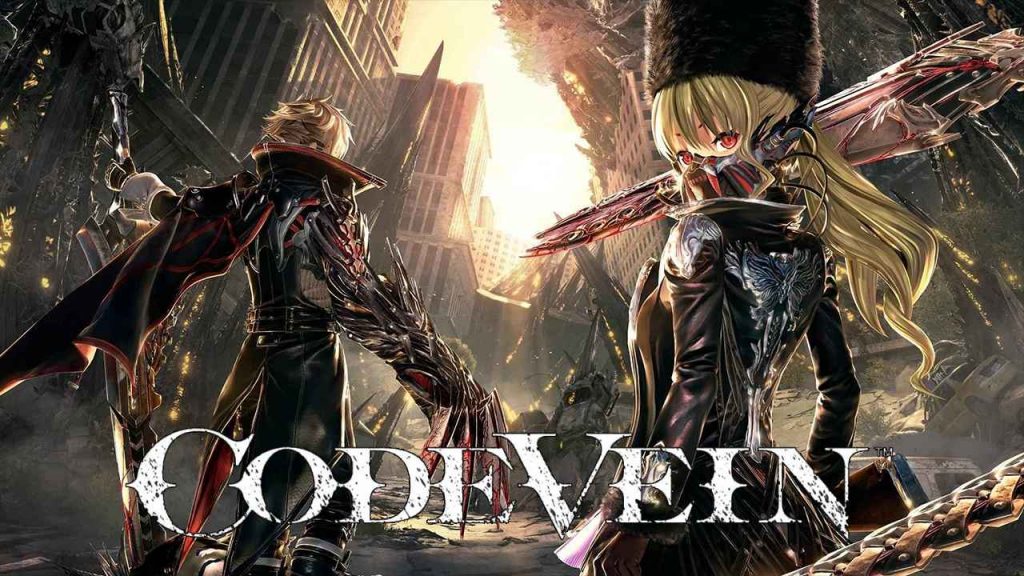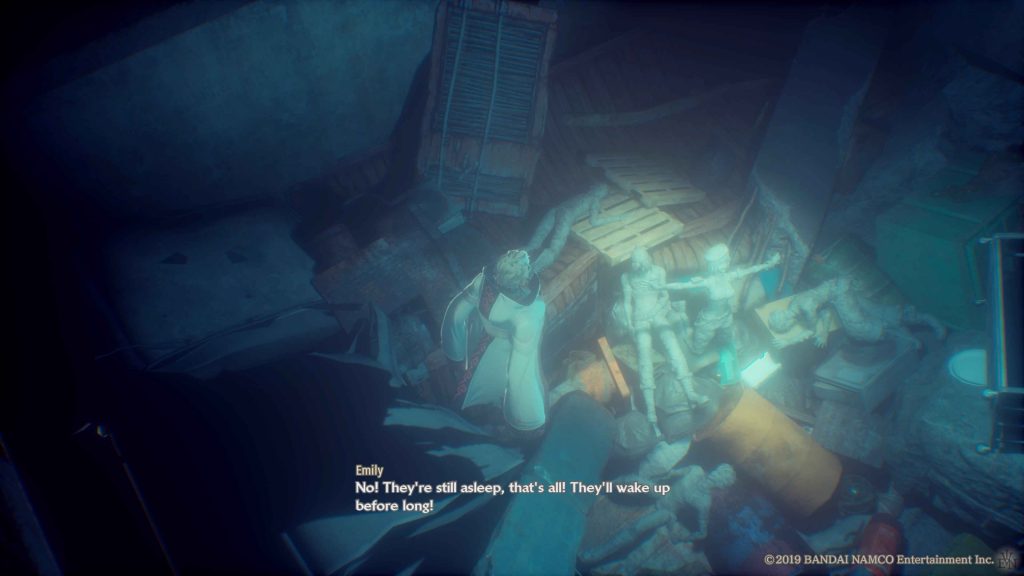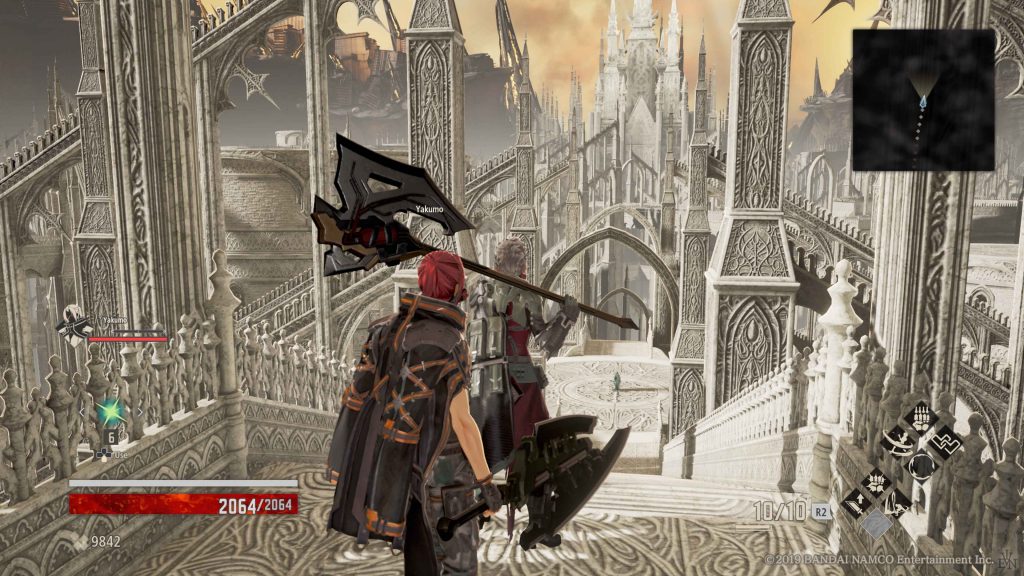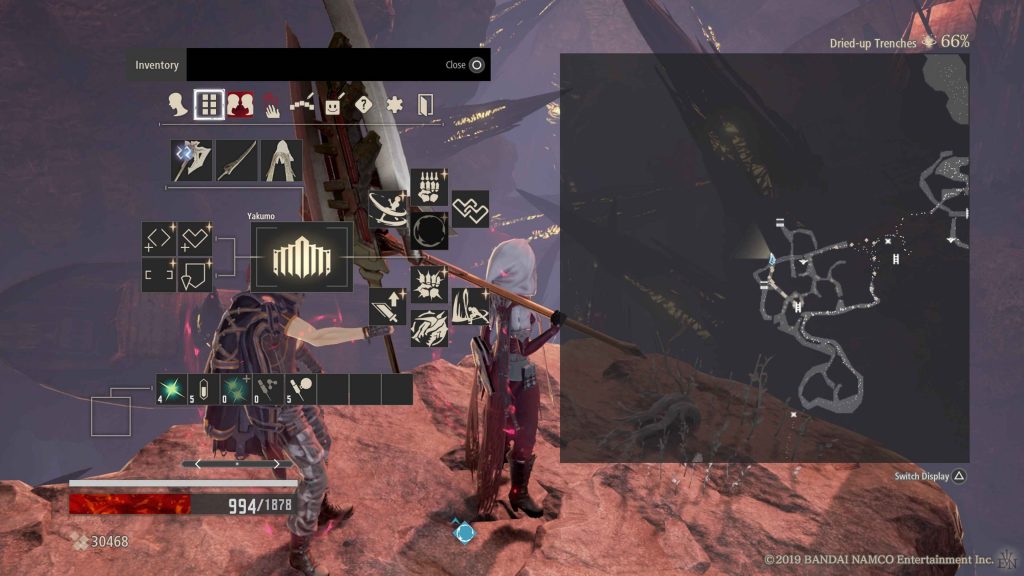
Coined “anime Dark Souls” by many, Code Vein attempts to mesh together the hard-nosed combat of the Soulsborne franchise with a post-apocalyptic anime-stylized backdrop. However, with such a stilted moniker, Code Vein has a high bar to reach. Does it have what it takes to stand with its comparative?
Code Vein PS4 Review
Narrative faux pas
You find yourself revived by an emotionless woman, whom you later learn calls herself Io. The world now finds itself engulfed in red mist with monsters roaming across desolate and dilapidated landscapes. Upon defeating your first boss, you discover that you can obtain Blood Codes, the vessels of human memories that long-dead humans have lost. After experiencing these Blood Codes, you begin to discover the cause of the calamity and what you must do to counteract it.
For all intents and purposes, Code Vein offers up a rather gorgeous, stylized version of the Soulsborne formula. The mythos behind it also contributes to quite an intriguing concept. However, instead of delivering that content naturally, Code Vein resorts to heavy bouts of exposition. Instead of a subtle approach, the game spoon feeds all the little details whenever possible. Couple that with generally half-hearted voice acting, with a few outliers, and you’re bound to miss a few crucial points along the way.

To contradict that point, you discover Blood Codes in your journeys. These codes offer two things, those being flashbacks and Vestiges, but the most relevant narratively are flashbacks. These flashbacks showcase little snippets of different characters you encounter, even yourself, and give a sense of humanity to the world. If the narrative had anchored more to this approach, then the full delivery would have been more engrossing rather than humdrum.
At the same time, these little nuggets of humanity feel so disjointed to the world proper that they almost feel like they belong in a different game entirely. This isn’t to say that both aren’t worth experiencing, because they both have their moments. They just don’t necessarily jive well together. The combination of subtle storytelling along with drastically blunt exposition begin to create a general lack of interest.
Combat falls short
Combat in Code Vein mimics the Soulsborne franchise: stamina-based actions and movements in a very hostile environment. However, Code Vein misses the lofty mark in a few very important ways. The first comes in the lock-on function: When strafing, you cannot run side to side; you only walk. This makes evading attacks more challenging than it should be, as it also affects your rolling distance.
To add to the targeting issue, enemies tend to jump around the map, spinning you around as you stay locked on them. This is doubly true for bosses, and exponentially so for large bosses. I often unlocked from the target when I needed to evade, but that usually left me unable to see the target when they flew past me. This issue is quite common with games like this, but the previously-mentioned lock-on issue makes these common issues more prevalent.
To make things worse, Code Vein has something of a timing issue that I cannot quite pinpoint. Bosses don’t seem to follow the same rules that you do, where you’re limited by stamina and resources. Oftentimes, a boss will bombard you with a sporadic combo, turn a bit, and then do it again. This is not a matter of difficulty but one of fairness.
This brings up one special thing about the Soulsborne games that Code Vein just does not seem to have: equality–which is not the same as difficulty. Everything in the world, whether monster or the player, is restricted by their stamina bar. If they run out of stamina, they can’t do anything. Even if the enemy is hard as nails, you know with confidence that you will have windows of opportunity.
Exploration stands out above everything else
One profound strength to Code Vein’s execution is exploration. With combat offering rather minimal resistance, the want to explore becomes stronger. This rewards you with new Blood Cores, weapons, and items to help you better yourself and get around. Besides, the locales, despite a couple outliers, are fun to look at and a joy to explore; but the level filled to the brim with flying buttresses could have used a heavy hand of variety.

Developing your player is another strong point. Weapon and equipment development mimic Soulsborne to the letter, but the real heart of Code Vein comes in which Vestige you use and how you equip yourself with them. Over 20 different cores exist in the game for you to find, and each one offers a different combat focus. My personal favorite is Hephaestus, which allows me to have a balance between attack and defense as well as play a support role to my companion while they do all the work.
I would be amiss if I didn’t mention that I came across some technical difficulties along the way. When going between major zones, I experienced deep dips in frame rates as well as texture pop-in and out. The texture issues also occurred in the rare random location from time to time as well. Either way, none of these issues themselves added problems to the game experience.
This is not Dark Souls Lite
Code Vein is compared to the Soulsborne series simply because it follows a similar equation. What makes the Soulsborne games so popular is the way that the games require full immersion in order to complete. Each enemy has the potential to destroy you because of a simple mistake or just bad luck. You may be good at the games, but you still have to care about the moves you make.
Code Vein does not ask this of its players, at least not for a long while. The companions you choose from offer up party dynamics that make the game more accessibly more quickly. One companion in particular, Yakumo, is an absolute workhorse that defeated many-a-boss with very little help from me. I tried playing with other companions, but they simply contributed damage or gave me buffs rather than engaged or disrupted enemies.

The longer I played, the more I became comfortable with what Code Vein allowed me to do. I felt motivated to continue exploring, with monster fights simply being part of the experience rather than the focal point. I even grew into the idea of being more of a support role for my companion. It felt kind of cool to help someone succeed rather than just winning on my own; notice the word “comfortable.”
Lots of options with little reason to use them
Even though I tried different Vestiges, I found myself sticking with Hephaestus. Some bosses made me rethink the skills and weapons I used, but I never really had to stray from my preferred Vestige once I obtained it. This is both good and bad: While it’s very easy to get comfortable in how you play, the game doesn’t nudge you to try out new combinations very often. You can try to maximize my combat experience with each new level, as they all have their own nuances that you can manipulate, but going in with the same setup will still get you through with minimal differences.
This becomes my biggest gripe with Code Vein: How it wants to do one thing but instead does another. So many different parts of the game mimic the Soulsborne franchise, even down to the sounds and texts used when defeating bosses, but its focus goes elsewhere. Arguably, this works in Code Vein’s favor simply because it allows a wide range of players to consume it more easily. In this regard, the game would have benefited more from taking its own direction completely rather than trying to copy aspects of one franchise and crudely paste in others.
The final point to make comes in the form of multiplayer. Conveniently, finding and joining other players isn’t as complicated as finding a particular item or anything. There’s a simple Distress option that you can use to bring in people or join other players. While playing with others felt incredibly empowering, it took what challenge the game did offer and threw it out the window. It just made the game mindlessly easy.
Code Vein succeeds and then disappoints
If on an island, Code Vein would be a rather respectable, albeit flawed game. It creates a world filled with lore and characters, and it includes an accessible combat experience. Since it attempts to mimic a highly-respected franchise and fuse it with other archetypes, the game begins to fall short of expectations. Many aspects of the game work well, but several important ones just don’t have the kind of necessary polish needed. Code Vein offers up a helping-hand introduction to games of its ilk, but it has a long way to go before it reaches its comparative.
Code Vein releases for PS4, Xbox One and PC on September 27, 2019.
Review code kindly provided by publisher.
Original Article © psu.com



No comments
Post a Comment